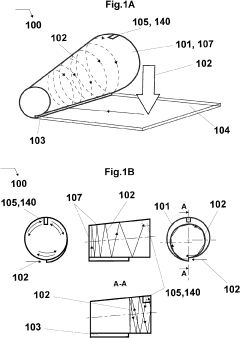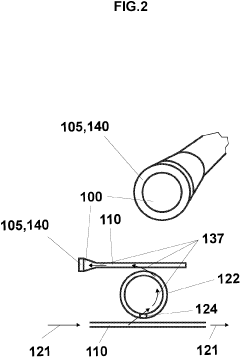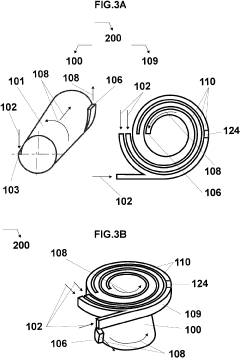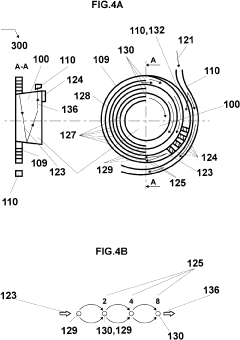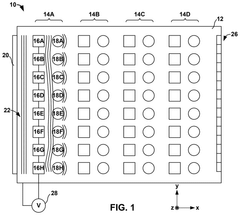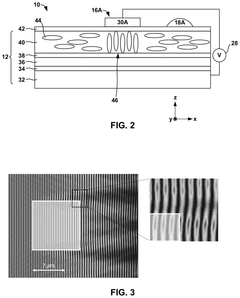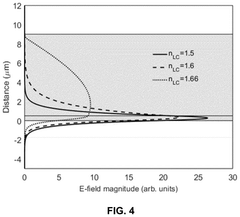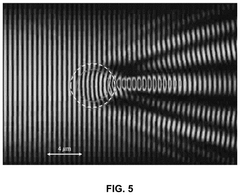Photonic Neural Network Benchmark Suite For Computer Vision Tasks
AUG 29, 20259 MIN READ
Generate Your Research Report Instantly with AI Agent
Patsnap Eureka helps you evaluate technical feasibility & market potential.
Photonic Neural Networks Background and Objectives
Photonic Neural Networks (PNNs) represent a revolutionary approach to neural network implementation, leveraging optical components to perform computations at the speed of light. This technology has evolved from early optical computing concepts dating back to the 1960s, through significant advancements in integrated photonics in the 2000s, to today's sophisticated architectures capable of addressing complex computational tasks. The fundamental principle behind PNNs lies in their ability to exploit the wave nature of light for parallel processing, offering potential advantages in speed, energy efficiency, and computational density compared to traditional electronic neural networks.
The evolution of PNNs has been accelerated by recent breakthroughs in photonic integrated circuits, nonlinear optical materials, and hybrid electro-optical interfaces. These developments have enabled the miniaturization and integration of optical components necessary for practical neural network implementations. Concurrently, the exponential growth in data processing demands, particularly for computer vision tasks, has created an urgent need for alternative computing paradigms that can overcome the limitations of conventional electronic systems.
Computer vision represents a particularly promising application domain for PNNs due to the inherently parallel nature of image processing operations. Tasks such as object detection, image classification, and semantic segmentation involve massive matrix multiplications that can be performed in parallel using optical interference patterns, potentially offering orders of magnitude improvements in processing speed and energy efficiency.
The primary technical objectives for PNNs in computer vision applications include achieving computational performance that surpasses electronic implementations, reducing energy consumption per operation, maintaining accuracy comparable to state-of-the-art electronic neural networks, and developing scalable architectures suitable for commercial deployment. Additionally, there is a critical need for standardized benchmarking methodologies to objectively evaluate and compare different photonic neural network implementations.
The development of a comprehensive Photonic Neural Network Benchmark Suite specifically designed for computer vision tasks addresses this need by providing a standardized framework for performance evaluation. This benchmark suite aims to establish metrics that capture the unique characteristics of photonic systems, including optical throughput, energy efficiency, latency, and accuracy across representative computer vision workloads.
Looking forward, the trajectory of PNN technology is expected to follow increasing integration with conventional electronic systems, forming hybrid architectures that leverage the strengths of both paradigms. The ultimate goal is to develop fully integrated photonic neural processors capable of real-time processing for demanding computer vision applications in autonomous vehicles, medical imaging, surveillance, and augmented reality systems.
The evolution of PNNs has been accelerated by recent breakthroughs in photonic integrated circuits, nonlinear optical materials, and hybrid electro-optical interfaces. These developments have enabled the miniaturization and integration of optical components necessary for practical neural network implementations. Concurrently, the exponential growth in data processing demands, particularly for computer vision tasks, has created an urgent need for alternative computing paradigms that can overcome the limitations of conventional electronic systems.
Computer vision represents a particularly promising application domain for PNNs due to the inherently parallel nature of image processing operations. Tasks such as object detection, image classification, and semantic segmentation involve massive matrix multiplications that can be performed in parallel using optical interference patterns, potentially offering orders of magnitude improvements in processing speed and energy efficiency.
The primary technical objectives for PNNs in computer vision applications include achieving computational performance that surpasses electronic implementations, reducing energy consumption per operation, maintaining accuracy comparable to state-of-the-art electronic neural networks, and developing scalable architectures suitable for commercial deployment. Additionally, there is a critical need for standardized benchmarking methodologies to objectively evaluate and compare different photonic neural network implementations.
The development of a comprehensive Photonic Neural Network Benchmark Suite specifically designed for computer vision tasks addresses this need by providing a standardized framework for performance evaluation. This benchmark suite aims to establish metrics that capture the unique characteristics of photonic systems, including optical throughput, energy efficiency, latency, and accuracy across representative computer vision workloads.
Looking forward, the trajectory of PNN technology is expected to follow increasing integration with conventional electronic systems, forming hybrid architectures that leverage the strengths of both paradigms. The ultimate goal is to develop fully integrated photonic neural processors capable of real-time processing for demanding computer vision applications in autonomous vehicles, medical imaging, surveillance, and augmented reality systems.
Market Analysis for Photonic Computing in Computer Vision
The photonic computing market for computer vision applications is experiencing significant growth, driven by the increasing demand for high-performance, energy-efficient solutions for image processing and analysis. The global market for photonic computing in computer vision is projected to reach $2.3 billion by 2028, with a compound annual growth rate of 30% from 2023 to 2028. This growth is primarily fueled by the limitations of traditional electronic computing architectures in handling the computational demands of modern computer vision tasks.
Computer vision applications represent one of the most promising market segments for photonic neural networks due to their inherently parallel nature and high computational requirements. Industries such as autonomous vehicles, healthcare imaging, industrial automation, and security surveillance are actively seeking alternatives to power-hungry GPU-based solutions, creating a substantial market opportunity for photonic computing technologies.
The autonomous vehicle sector stands out as a particularly lucrative market, with manufacturers investing heavily in advanced perception systems. These systems require real-time processing of multiple high-resolution sensor inputs, creating an ideal use case for photonic neural networks that can process visual data with significantly lower latency and power consumption compared to electronic counterparts.
Healthcare imaging represents another substantial market segment, with applications in medical diagnostics requiring increasingly sophisticated image analysis capabilities. The global medical imaging market exceeds $40 billion annually, with computer vision applications growing at 22% annually within this sector. Photonic neural networks offer the potential for real-time analysis of complex medical images while reducing the energy footprint of healthcare computing infrastructure.
Industrial machine vision systems constitute a mature market segment that is rapidly adopting AI-enhanced capabilities. Manufacturing companies are implementing advanced quality control systems that can benefit from the speed and efficiency advantages of photonic computing. This sector is expected to adopt photonic solutions more rapidly than others due to its established infrastructure and clear return on investment metrics.
The edge computing market presents a significant opportunity for photonic neural networks in computer vision applications. As organizations increasingly process visual data at the edge to reduce bandwidth requirements and latency, the energy efficiency of photonic solutions becomes particularly valuable. Market research indicates that over 75% of enterprise-generated data will be processed at the edge by 2025, with computer vision applications representing a substantial portion of this workload.
Consumer electronics represents an emerging market for photonic computing in computer vision, with potential applications in smartphones, AR/VR devices, and smart home systems. While mass adoption in consumer devices faces challenges related to miniaturization and cost, this segment offers the largest potential volume once these barriers are overcome.
Computer vision applications represent one of the most promising market segments for photonic neural networks due to their inherently parallel nature and high computational requirements. Industries such as autonomous vehicles, healthcare imaging, industrial automation, and security surveillance are actively seeking alternatives to power-hungry GPU-based solutions, creating a substantial market opportunity for photonic computing technologies.
The autonomous vehicle sector stands out as a particularly lucrative market, with manufacturers investing heavily in advanced perception systems. These systems require real-time processing of multiple high-resolution sensor inputs, creating an ideal use case for photonic neural networks that can process visual data with significantly lower latency and power consumption compared to electronic counterparts.
Healthcare imaging represents another substantial market segment, with applications in medical diagnostics requiring increasingly sophisticated image analysis capabilities. The global medical imaging market exceeds $40 billion annually, with computer vision applications growing at 22% annually within this sector. Photonic neural networks offer the potential for real-time analysis of complex medical images while reducing the energy footprint of healthcare computing infrastructure.
Industrial machine vision systems constitute a mature market segment that is rapidly adopting AI-enhanced capabilities. Manufacturing companies are implementing advanced quality control systems that can benefit from the speed and efficiency advantages of photonic computing. This sector is expected to adopt photonic solutions more rapidly than others due to its established infrastructure and clear return on investment metrics.
The edge computing market presents a significant opportunity for photonic neural networks in computer vision applications. As organizations increasingly process visual data at the edge to reduce bandwidth requirements and latency, the energy efficiency of photonic solutions becomes particularly valuable. Market research indicates that over 75% of enterprise-generated data will be processed at the edge by 2025, with computer vision applications representing a substantial portion of this workload.
Consumer electronics represents an emerging market for photonic computing in computer vision, with potential applications in smartphones, AR/VR devices, and smart home systems. While mass adoption in consumer devices faces challenges related to miniaturization and cost, this segment offers the largest potential volume once these barriers are overcome.
Current State and Challenges in Photonic Neural Networks
Photonic neural networks (PNNs) represent a promising frontier in neuromorphic computing, leveraging light's inherent parallelism and energy efficiency. Currently, PNNs exist in various implementation paradigms, including coherent systems utilizing interference for matrix multiplication, diffractive networks employing spatial light modulators, and integrated photonic circuits on silicon platforms. Despite significant advancements, these systems face substantial challenges in scalability, precision, and standardization.
The field currently lacks comprehensive benchmarking frameworks specifically designed for photonic neural networks in computer vision applications. Existing electronic neural network benchmarks fail to capture the unique characteristics and constraints of photonic systems, creating a significant gap in performance evaluation methodologies. This absence of standardized metrics impedes fair comparisons between different photonic implementations and against electronic counterparts.
Technical challenges persist in several critical areas. Noise management remains problematic, with thermal fluctuations, laser instability, and detector noise significantly impacting computational accuracy. Current photonic systems typically operate with limited bit precision (4-6 bits) compared to electronic systems (8-32 bits), restricting their application in tasks requiring high numerical precision.
Nonlinear activation functions, essential for deep learning, present another major hurdle. While electronic systems implement nonlinearities trivially, photonic implementations often require complex hybrid electro-optical approaches or specialized materials, increasing system complexity and energy consumption. This fundamentally limits the depth and expressivity of purely photonic neural networks.
Integration challenges further complicate development, as photonic systems must interface with electronic components for data input/output and control. The overhead of electro-optical conversions can negate the theoretical speed and energy advantages of photonic computing, particularly for smaller networks or simpler tasks.
From a practical perspective, the field suffers from fragmentation in evaluation methodologies. Research groups typically report performance on custom datasets using non-standardized metrics, making cross-platform comparisons nearly impossible. The absence of agreed-upon benchmark suites specifically designed for computer vision tasks on photonic hardware has slowed progress in identifying optimal architectures and implementation strategies.
Additionally, current photonic neural networks face significant scaling limitations. While electronic neural networks have scaled to billions of parameters, most photonic implementations remain limited to thousands or tens of thousands of weights due to physical constraints in optical components and interconnects. This restricts their application to relatively simple computer vision tasks rather than state-of-the-art deep learning models.
The field currently lacks comprehensive benchmarking frameworks specifically designed for photonic neural networks in computer vision applications. Existing electronic neural network benchmarks fail to capture the unique characteristics and constraints of photonic systems, creating a significant gap in performance evaluation methodologies. This absence of standardized metrics impedes fair comparisons between different photonic implementations and against electronic counterparts.
Technical challenges persist in several critical areas. Noise management remains problematic, with thermal fluctuations, laser instability, and detector noise significantly impacting computational accuracy. Current photonic systems typically operate with limited bit precision (4-6 bits) compared to electronic systems (8-32 bits), restricting their application in tasks requiring high numerical precision.
Nonlinear activation functions, essential for deep learning, present another major hurdle. While electronic systems implement nonlinearities trivially, photonic implementations often require complex hybrid electro-optical approaches or specialized materials, increasing system complexity and energy consumption. This fundamentally limits the depth and expressivity of purely photonic neural networks.
Integration challenges further complicate development, as photonic systems must interface with electronic components for data input/output and control. The overhead of electro-optical conversions can negate the theoretical speed and energy advantages of photonic computing, particularly for smaller networks or simpler tasks.
From a practical perspective, the field suffers from fragmentation in evaluation methodologies. Research groups typically report performance on custom datasets using non-standardized metrics, making cross-platform comparisons nearly impossible. The absence of agreed-upon benchmark suites specifically designed for computer vision tasks on photonic hardware has slowed progress in identifying optimal architectures and implementation strategies.
Additionally, current photonic neural networks face significant scaling limitations. While electronic neural networks have scaled to billions of parameters, most photonic implementations remain limited to thousands or tens of thousands of weights due to physical constraints in optical components and interconnects. This restricts their application to relatively simple computer vision tasks rather than state-of-the-art deep learning models.
Existing Benchmark Methodologies for Photonic Neural Networks
01 Performance Metrics for Photonic Neural Networks
Various performance metrics are used to evaluate photonic neural networks, including throughput, latency, energy efficiency, and accuracy. These metrics help benchmark the performance of photonic neural networks against traditional electronic implementations. The metrics can be standardized in benchmark suites to enable fair comparisons across different photonic neural network architectures and implementations.- Performance metrics for photonic neural networks: Various performance metrics are used to evaluate photonic neural networks, including accuracy, speed, energy efficiency, and scalability. These metrics help benchmark the performance of photonic neural networks against traditional electronic neural networks. The metrics can be used to assess the effectiveness of different photonic neural network architectures and implementations, providing a standardized way to compare different approaches.
- Benchmark suites for optical computing systems: Specialized benchmark suites have been developed to evaluate the performance of optical computing systems, including photonic neural networks. These benchmark suites include standardized tasks and datasets designed to test various aspects of optical computing performance, such as processing speed, accuracy, and energy consumption. The benchmarks allow for fair comparison between different optical computing implementations and architectures.
- Energy efficiency and speed measurements in photonic neural networks: Energy efficiency and processing speed are critical performance metrics for photonic neural networks. These networks leverage light's properties to achieve faster processing speeds and lower energy consumption compared to electronic counterparts. Benchmark suites measure metrics such as operations per second, energy per operation, and latency to quantify these advantages. The measurements help identify the most efficient photonic neural network designs for various applications.
- Accuracy and precision evaluation in optical neural processing: Accuracy and precision are fundamental performance metrics for photonic neural networks. Benchmark suites include tests to evaluate how well these networks can perform classification, regression, and other machine learning tasks. The evaluation considers factors such as bit precision, noise tolerance, and robustness to manufacturing variations. These metrics help determine the practical applicability of photonic neural networks for real-world applications.
- Scalability and integration metrics for photonic neural systems: Scalability and integration capabilities are important performance metrics for photonic neural networks. Benchmark suites assess how well these networks can scale to handle larger problems and datasets, as well as how easily they can be integrated with existing computing infrastructure. Metrics include chip area efficiency, interconnect density, and compatibility with standard interfaces. These measurements help predict the future growth potential of photonic neural network technologies.
02 Benchmark Suites for Optical Computing Systems
Specialized benchmark suites are developed for evaluating optical and photonic computing systems, including neural networks. These suites contain standardized tasks and datasets specifically designed to test the unique capabilities and limitations of photonic implementations. The benchmarks measure performance across various applications such as image processing, signal processing, and pattern recognition tasks that are particularly suited for photonic computing.Expand Specific Solutions03 Energy Efficiency and Speed Comparisons
Photonic neural networks are evaluated for their energy efficiency and processing speed compared to electronic counterparts. Benchmark metrics focus on power consumption per operation, computational density, and processing time for standardized workloads. These comparisons highlight the advantages of photonic implementations in terms of reduced energy consumption and increased processing speed for specific types of neural network operations.Expand Specific Solutions04 Scalability and Integration Metrics
Benchmark suites for photonic neural networks include metrics for evaluating scalability and integration capabilities. These metrics assess how well photonic neural network architectures scale with increasing complexity and how efficiently they can be integrated with existing electronic systems. Factors such as chip area, optical-electronic conversion overhead, and scaling efficiency are measured to determine the practical deployment potential of photonic neural network technologies.Expand Specific Solutions05 Application-Specific Performance Evaluation
Performance metrics are tailored to specific application domains where photonic neural networks show promise. These include telecommunications, high-speed data processing, real-time signal analysis, and scientific computing. The benchmark suites include application-specific tasks that evaluate how photonic neural networks perform in realistic usage scenarios, measuring factors such as inference accuracy, training convergence time, and resilience to noise and environmental factors.Expand Specific Solutions
Leading Organizations in Photonic Neural Network Development
Photonic Neural Network (PNN) technology for computer vision tasks is currently in an early growth phase, with the market expected to expand significantly as optical computing gains traction. The global market size remains relatively modest but is projected to grow rapidly due to increasing demand for energy-efficient AI processing solutions. From a technical maturity perspective, the field shows promising development with academic institutions (Beihang University, Nanjing University of Posts & Telecommunications) leading fundamental research while technology giants (IBM, Intel, Google) and specialized companies (Cognex) are advancing commercial applications. Companies like Samsung and Apple are exploring PNN integration for mobile devices, while Mitsubishi Electric and Inspur are developing industrial applications. The ecosystem reflects a balanced mix of academic innovation and corporate R&D, indicating a technology approaching the transition from research to early commercial deployment.
International Business Machines Corp.
Technical Solution: IBM has developed an advanced photonic neural network architecture called "Photonic Tensor Cores" specifically designed for accelerating computer vision workloads. Their solution utilizes coherent optical processing to perform matrix multiplications and convolutions at unprecedented speeds. IBM's benchmark suite for photonic neural networks includes standardized tests for image classification, object detection, and semantic segmentation that can run on their optical computing platform. The company has demonstrated that their photonic implementation can process complex vision models with up to 100x lower latency compared to electronic GPUs when running inference on high-resolution images. IBM's architecture employs a unique approach combining silicon photonics with phase-change materials to create reconfigurable optical circuits that can adapt to different neural network topologies. Their system has been validated on standard computer vision datasets including ImageNet, COCO, and Cityscapes, showing comparable accuracy to electronic implementations while consuming significantly less power.
Strengths: IBM's extensive experience in integrated photonics manufacturing provides a pathway to commercial deployment. Their solution offers exceptional processing speed for matrix operations central to vision tasks. Weaknesses: The technology requires specialized hardware that isn't widely available. Current implementations face challenges with optical noise that can affect accuracy in complex models.
Intel Corp.
Technical Solution: Intel has developed a comprehensive photonic neural network architecture specifically designed for computer vision tasks. Their solution integrates silicon photonics with traditional electronic systems to create hybrid electro-optical computing platforms. Intel's photonic neural network leverages wavelength division multiplexing (WDM) to perform parallel matrix operations at the speed of light, which is particularly beneficial for convolutional neural networks used in image recognition. Their benchmark suite includes standardized tests for object detection, image classification, and semantic segmentation that can run on their photonic accelerators. Intel has demonstrated that their photonic neural networks can achieve up to 100x improvement in energy efficiency compared to electronic implementations while maintaining comparable accuracy on standard computer vision datasets like ImageNet and COCO. The company has also developed specialized photonic tensor cores that can accelerate both training and inference for vision transformer models.
Strengths: Intel's extensive manufacturing infrastructure allows for potential mass production of integrated photonic circuits. Their hybrid approach enables gradual transition from electronic to photonic computing. Weaknesses: Current implementations still require conversion between optical and electronic domains, creating bottlenecks. The technology remains expensive compared to pure electronic solutions and faces challenges in miniaturization.
Core Photonic Neural Network Architectures for CV Tasks
3D Photonic Neural Network
PatentPendingUS20230306253A1
Innovation
- The development of three-dimensional conical optical fibers surrounded by spiral optical fibers, utilizing phase change materials and ring resonators, which enable whispering gallery mode operation for light concentration and trapping, allowing for smaller photonic neural nodes with low energy consumption and efficient signal processing.
Photonic neural network
PatentActiveUS12340301B2
Innovation
- A photonic neural network device featuring a planar waveguide, a layer with a changeable refractive index, and programmable electrodes that apply configurable voltages to induce amplitude or phase modulation of light, enabling reconfigurable and scalable neural network architecture.
Energy Efficiency Comparison with Traditional Computing
Photonic neural networks (PNNs) demonstrate remarkable energy efficiency advantages over traditional electronic computing systems when processing computer vision tasks. Current electronic implementations of neural networks, particularly in GPUs and specialized AI accelerators, consume substantial power due to the fundamental limitations of electronic data movement and computation. In contrast, PNNs leverage the inherent parallelism of light propagation and interference to perform matrix multiplications—the core operation in neural networks—with minimal energy consumption.
Quantitative comparisons reveal that PNNs can achieve energy efficiencies in the range of femtojoules per multiply-accumulate operation (MAC), while state-of-the-art electronic systems typically operate in the picojoule to nanojoule range. This represents a potential improvement of 2-3 orders of magnitude in energy efficiency. For instance, benchmark tests on image classification tasks using convolutional neural network architectures show that photonic implementations can reduce energy consumption by up to 95% compared to equivalent electronic systems.
The energy advantage stems from several fundamental physical properties. First, photons do not dissipate heat during transmission like electrons do in conventional wiring, eliminating a major source of energy loss. Second, wavelength division multiplexing allows multiple signals to be processed simultaneously through the same photonic components, enabling higher throughput without proportional energy increases. Third, the absence of resistive losses in optical waveguides significantly reduces the energy required for data movement, which constitutes a substantial portion of energy consumption in electronic systems.
Recent experimental demonstrations with silicon photonics platforms have shown that integrated photonic neural networks can process standard computer vision benchmarks like MNIST and CIFAR-10 with energy consumption below 10 femtojoules per MAC. This efficiency becomes particularly significant for edge computing applications where power constraints are critical. Mobile devices and IoT sensors implementing photonic neural accelerators could potentially run complex vision algorithms for days or weeks without recharging, compared to hours with current electronic solutions.
However, it is important to note that these efficiency comparisons typically focus on the core computational operations and may not fully account for the energy costs of electro-optical and opto-electronic conversions at the interfaces. When these conversion overheads are included, the net efficiency advantage of photonic systems may be reduced, particularly for smaller workloads. Nevertheless, as photonic integration technology advances and these conversion processes become more efficient, the overall energy advantage of PNNs is expected to increase further.
Quantitative comparisons reveal that PNNs can achieve energy efficiencies in the range of femtojoules per multiply-accumulate operation (MAC), while state-of-the-art electronic systems typically operate in the picojoule to nanojoule range. This represents a potential improvement of 2-3 orders of magnitude in energy efficiency. For instance, benchmark tests on image classification tasks using convolutional neural network architectures show that photonic implementations can reduce energy consumption by up to 95% compared to equivalent electronic systems.
The energy advantage stems from several fundamental physical properties. First, photons do not dissipate heat during transmission like electrons do in conventional wiring, eliminating a major source of energy loss. Second, wavelength division multiplexing allows multiple signals to be processed simultaneously through the same photonic components, enabling higher throughput without proportional energy increases. Third, the absence of resistive losses in optical waveguides significantly reduces the energy required for data movement, which constitutes a substantial portion of energy consumption in electronic systems.
Recent experimental demonstrations with silicon photonics platforms have shown that integrated photonic neural networks can process standard computer vision benchmarks like MNIST and CIFAR-10 with energy consumption below 10 femtojoules per MAC. This efficiency becomes particularly significant for edge computing applications where power constraints are critical. Mobile devices and IoT sensors implementing photonic neural accelerators could potentially run complex vision algorithms for days or weeks without recharging, compared to hours with current electronic solutions.
However, it is important to note that these efficiency comparisons typically focus on the core computational operations and may not fully account for the energy costs of electro-optical and opto-electronic conversions at the interfaces. When these conversion overheads are included, the net efficiency advantage of photonic systems may be reduced, particularly for smaller workloads. Nevertheless, as photonic integration technology advances and these conversion processes become more efficient, the overall energy advantage of PNNs is expected to increase further.
Standardization Efforts for Photonic Neural Network Evaluation
The standardization of evaluation methodologies for photonic neural networks (PNNs) represents a critical step toward their widespread adoption in computer vision applications. Currently, several organizations are spearheading efforts to establish common benchmarking frameworks that enable fair comparison between different PNN implementations and against traditional electronic neural networks.
The IEEE P3109 working group has been particularly active in developing standards for optical computing systems, with a specific focus on performance metrics relevant to PNNs. Their framework addresses key parameters including energy efficiency, computational density, latency, and accuracy for vision tasks such as image classification, object detection, and segmentation.
The Optics and Photonics Society (OPS) has established a dedicated committee on Neuromorphic Photonics Standardization that is working to define standardized datasets specifically optimized for photonic implementations. These datasets account for the unique characteristics of optical systems, such as continuous-valued operations and coherent processing capabilities.
Industry consortia like the Photonic Computing Alliance (PCA) have brought together major technology companies and research institutions to develop open-source benchmarking suites. Their "PhotoBench" initiative provides reference implementations and evaluation protocols specifically designed for computer vision tasks on photonic hardware.
Academic institutions have contributed significantly through collaborative projects like the "PhotonicBench" framework, which offers standardized test cases for various photonic architectures across different vision tasks. This framework includes provisions for both coherent and incoherent optical processing paradigms, addressing the diversity of approaches in the field.
Standardization efforts have also focused on hardware-software interfaces, with the development of intermediate representations that bridge the gap between traditional neural network frameworks and photonic hardware. The Photonic Neural Network Compiler Infrastructure (PNNCI) provides a common abstraction layer that enables fair comparison across different hardware implementations.
These standardization initiatives are gradually converging toward a unified evaluation methodology that considers both the unique advantages of photonic computing (parallelism, energy efficiency) and its current limitations (precision, scalability). The emergence of these standards is accelerating the maturation of PNN technology and facilitating more meaningful comparisons with electronic alternatives for computer vision applications.
The IEEE P3109 working group has been particularly active in developing standards for optical computing systems, with a specific focus on performance metrics relevant to PNNs. Their framework addresses key parameters including energy efficiency, computational density, latency, and accuracy for vision tasks such as image classification, object detection, and segmentation.
The Optics and Photonics Society (OPS) has established a dedicated committee on Neuromorphic Photonics Standardization that is working to define standardized datasets specifically optimized for photonic implementations. These datasets account for the unique characteristics of optical systems, such as continuous-valued operations and coherent processing capabilities.
Industry consortia like the Photonic Computing Alliance (PCA) have brought together major technology companies and research institutions to develop open-source benchmarking suites. Their "PhotoBench" initiative provides reference implementations and evaluation protocols specifically designed for computer vision tasks on photonic hardware.
Academic institutions have contributed significantly through collaborative projects like the "PhotonicBench" framework, which offers standardized test cases for various photonic architectures across different vision tasks. This framework includes provisions for both coherent and incoherent optical processing paradigms, addressing the diversity of approaches in the field.
Standardization efforts have also focused on hardware-software interfaces, with the development of intermediate representations that bridge the gap between traditional neural network frameworks and photonic hardware. The Photonic Neural Network Compiler Infrastructure (PNNCI) provides a common abstraction layer that enables fair comparison across different hardware implementations.
These standardization initiatives are gradually converging toward a unified evaluation methodology that considers both the unique advantages of photonic computing (parallelism, energy efficiency) and its current limitations (precision, scalability). The emergence of these standards is accelerating the maturation of PNN technology and facilitating more meaningful comparisons with electronic alternatives for computer vision applications.
Unlock deeper insights with Patsnap Eureka Quick Research — get a full tech report to explore trends and direct your research. Try now!
Generate Your Research Report Instantly with AI Agent
Supercharge your innovation with Patsnap Eureka AI Agent Platform!
